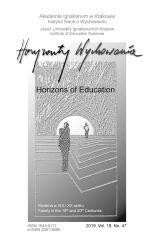Praca z rodziną biologiczną dziecka umieszczonego w pieczy zastępczej czynnikiem optymalizującym reintegrację rodziny
Abstract
RESEARCH OBJECTIVE: The objective of the article is to attempt to synthetically present problem areas and issues related to work with the biological family of a child placed in a foster care institution, and to present this task as a current and urgent social need.
THE RESEARCH PROBLEM AND METHODS: The problem question was posed as follows: what issues are taken into account in the pedagogical reflection on the importance of working with the biological family of a child placed in foster care? The article attempts to demonstrate the need to intensify and optimise this process.
THE PROCESS OF ARGUMENTATION: The realisation of the assumed goal and the answer to the formulated problem question is included in the conclusion process, which consists of: introducing the issue by analysing the basic assumptions of the child and family support system, and presenting the essence of the contact of the child placed in foster care with the biological family for the family reintegration process.
RESEARCH RESULTS: Reflection on the addressed issues indicates the multifaceted nature of the presented area. The results of the data the article refers to indicate that the foster care system does not provide children with the expected degree of stable educational environment assumed in the legislation.
CONCLUSIONS, INNOVATIONS, AND RECOMMENDATIONS: An urgent need was observed to prepare optimal models of support for families whose children are in foster care. In the face of new educational challenges, it also seems necessary to undertake the indispensable efforts to-wards the development of knowledge, skills and competences not only of social workers, but also of students of pedagogy and teaching degrees who should be prepared to undertake the necessary activities in working with the biological family and the child placed in foster care.
References
Błażejewska, K. (2014). Bariery i szanse rodzicielstwa zastępczego. Rodzina zastępcza receptą na kryzys?. „Pogranicze. Studia Społeczne”, tom XXIV, s. 167-179.
Colton, M. (2001). Tendencje w opiece zastępczej. W: Z. Stelmaszuk (red.). Zmiany w systemie opieki nad dziećmi i młodzieżą – perspektywa europejska (s. 170-183). Katowice: Wydawnictwo Naukowe Śląsk”.
Kaczmarek, M. (2011). Pomoc i interwencja w rodzinie, czyli co każdy pracujący z dzieckiem i rodziną wiedzieć powinien. Warszawa: Mazowieckie Centrum Polityki Społecznej.
NIK o działaniach powiatów na rzecz tworzenia i wsparcia rodzin zastępczych, pobrane z: https://www.nik.gov.pl/aktualnosci/nik-o-dzialaniach-powiatow-na-rzecz-tworzenia-i-nbsp-wsparcia-rodzin-zastepczych.html (12.03.2019)
Pietruszka, L. (2016). The principle of subsidiarity in social work with the family – pedagogical implications. W: L. Pietruszka (red.). Opieka – wychowanie – wsparcie. Współczesne wyzwania dla teorii i praktyki pedagogicznej (s. 105-122). Lublin: Wyd. KUL.
Rodzinna piecza zastępcza w 2017 roku, pobrane z: https://stat.gov.pl/obszary-tematyczne/dzieci-i-rodzina/dzieci/rodzinna-piecza-zastepcza-w-2017-roku,1,2.html (12.03.2019)
Stasiak, S. (red.). (2007). Rodzinne formy opieki zastępczej. Poradnik prawny. Warszawa: Wydawnictwo Stowarzyszenie Interwencji Prawnej.
Stelmaszuk, Z. (1998). Szanse reintegracji rodziny w systemie opieki nad dzieckiem. W: M. Kolankiewicz (red.). Zagrożone dzieciństwo. Rodzinne i instytucjonalne formy opieki, (s. 108 – 136). Warszawa: Wydawnictwa Szkolne i Pedagogiczne.
Stierlin, H., Rucker-Embden, I., Wetzel, N., Wirshing M. (1999). Pierwszy wywiad z rodziną. Gdańsk: Gdańskie Wydawnictwo Psychologiczne.
Trubiłowicz, E., Szczygielska, M., Skwarka-Buzała, A., Langer-Fyda M. (2017). Mapa pomocy rodzinie w kontekście umieszczenia dziecka w pieczy zastępczej. Kraków: Regionalny Ośrodek Polityki Społecznej.
Wosik-Kawala, D. (2015). Dziecko wychowywane w rodzinie zastępcze. „Wychowanie w rodzinie”, tom 11, s. 271-288.
Copyright (c) 2020 Lidia Pietruszka

This work is licensed under a Creative Commons Attribution-NoDerivatives 4.0 International License.
Authors who publish in this journal agree to the following terms:
- Authors retain the copyright to their work while granting the journal the right of first publication. The work will be simultaneously licensed under a CC BY-ND license, which permits others to share the work with proper credit given to the author and the original publication in this journal.
- Authors may enter into additional, non-exclusive agreements for the distribution of the published version of the work (e.g., posting it in an institutional repository or publishing it in another journal), provided that the original publication in this journal is acknowledged.
We allow and encourage authors to share their work online (e.g., in institutional repositories or on personal websites) both before and during the submission process, as this can foster beneficial exchanges and lead to earlier and increased citations of the published work. (See The Effect of Open Access). We recommend using any of the following academic networking platforms:





